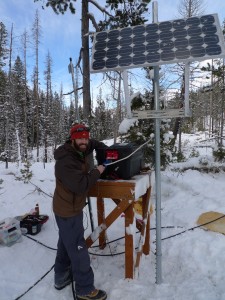7 October 2014
Detecting avalanches from sounds we can’t hear
Posted by kwheeling
By Kate Wheeling
Researchers have developed a new avalanche monitoring method that uses sound below the range of human hearing to detect and track these deadly and destructive snow slides. The technique can detect an avalanche from the moment it starts, picking up the unheard thump of a rupture in the snowpack that can precede the snow cascade. It can then track the avalanche’s path second by second down the mountain.

Scott Havens sets up part of an infrasound array to detect avalanches in the mountains surrounding Central Idaho’s Highway 21, known as Avalanche Alley.
Credit: Scott Havens
In a new study published last month in Geophysical Research Letters, a journal of the American Geophysical Union, scientists report using an array of infrasound detectors on a mountainside to pick up low-frequency sound waves emitted from one of a series of January, 2012, avalanches in Idaho’s Canyon Creek corridor.
Fourteen seconds before the main burst of infrasound began, the sensors were able to record a distinctive “whumpf,”—the sound of the snowpack failure that preceded the downward plunge, said Scott Havens, a doctoral student in geophysics at Boise State University in Idaho and the lead author of the new study. This study documents for the first time that infrasound sensors can detect this avalanche-triggering snowpack failure, he said.
Seismometers and upward looking radars placed in the avalanche path are currently used to track avalanches, but they only provide estimates of the average or peak velocity of the snow, according to Havens. The new infrasound technique gives scientists a more detailed look at the speed and volume of these snow slides than those other tracking methods, plus the ability to trace an avalanche to its source, or the initial snowpack failure, he noted.
Infrasound waves, in the range of 1 to 20 hertz, are sound waves below the threshold of human hearing. They can travel great distances—many times around the Earth—before diminishing in strength, making the waves detectable over long distances.
Scientists first learned that natural events like avalanches, earthquakes and volcanic eruptions could generate infrasound when they set up low-frequency sensors to detect nuclear explosions from afar during the Cold War. Instruments that can sense low-frequency sound waves are able to hear the early rumblings of an avalanche from thousands of kilometers (thousands of miles) away.
“Each avalanche seems to have a voice print,” said Alfred Bedard, a research scientist at the National Oceanic and Atmospheric Administration’s Environmental Technology Laboratory in Boulder, Colorado and a pioneer in the use of infrasound detection. “The frequency [of the infrasound wave] of a large avalanche is different from the frequency of a small avalanche.”
The more detailed information gleaned from infrasound could help scientists fine-tune models that predict snowpack stability and the volume of avalanche debris, said David Fee, an assistant professor at the Geophysical Institute of the University of Alaska Fairbanks, who was not involved in the new study.
Havens said he and his colleagues are developing the infrasound technique to provide the Idaho Transportation Department with its first real-time avalanche detection system. But, he cautions, it’s not a warning system. “Fourteen seconds is just not enough time between when the [snowpack] failure occurs to when you can get the word out,” said Havens.
For the new study, the researchers hiked into the mountains surrounding Central Idaho’s Highway 21, known to locals as Avalanche Alley, and left behind three infrasound sensors at various points on the mountain. The sensors, enclosed in boxes mounted on poles of various heights above the snowpack and spaced 30 meters (98 feet) apart, were equipped with cell phone microphones modified to pick up low- frequency sound waves.
On January 19, 2012, heavy snowfall triggered a series of 57 avalanches on the mountain. “It was definitely one of the larger storms that the highway has ever seen,” said Havens.
The team’s sensors happened to be just 550 meters (1805 feet) away from the avalanche start zone. That was close enough for the study’s authors to be able to estimate from the sensor data where the initial snowpack failure occurred and then gauge the avalanche’s speed throughout the 64-second event.

The avalanche buried Highway 21 in piles of snow and debris eight meters (26 feet) high in some places, blocking off the roadway.
Credit: Scott Havens
The initial “whumpf” was followed by fourteen seconds of silence as snow began tumbling down the mountainside. Researchers hypothesize that infrasound is generated at the turbulent front of avalanches, where the falling snow displaces air in its path, setting off waves of both infrasound and audible sound. But a small amount of snow isn’t enough to displace much air, so it took fourteen seconds for the avalanche to pick up enough snow and speed to generate a detectable amount of infrasound.
After 43 seconds the avalanche reached its maximum velocity of about 130 kilometers per hour (81 miles per hour), faster than a sprinting cheetah but no match for Marty McFly driving a time-traveling DeLorean in “Back to the Future.” Ten seconds and 300 meters (984 feet) later, the avalanche hit the highway and began to slow down as eight meters (26 feet) of snow piled on top of the roadway and into the stream beyond.
– Kate Wheeling is a science writing intern in the AGU’s Public Information department.


 GeoSpace is a blog on Earth and space science, managed by AGU’s Public Information staff. The blog features posts by AGU writers and guest contributors on all sorts of relevant science topics, but with a focus on new research and geo and space sciences-related stories that are currently in the news.
GeoSpace is a blog on Earth and space science, managed by AGU’s Public Information staff. The blog features posts by AGU writers and guest contributors on all sorts of relevant science topics, but with a focus on new research and geo and space sciences-related stories that are currently in the news.